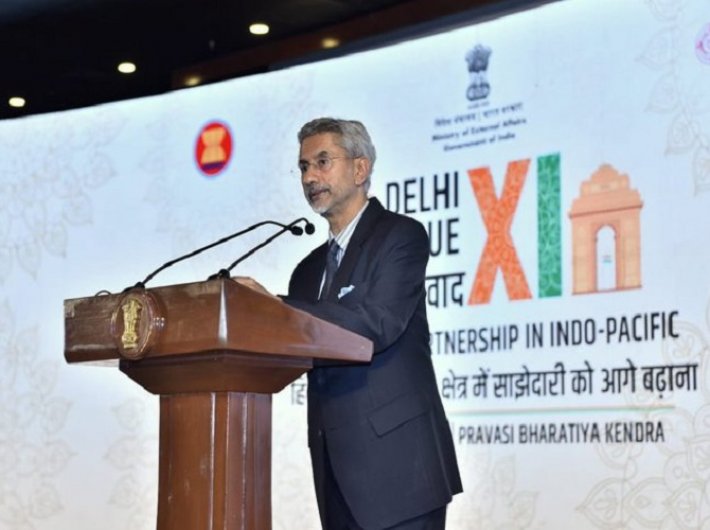EAM Jaishankar’s remarks at Delhi Dialogue come ahead of second India-US 2+2 ministerial dialogue
Faced with the situation emerging around the world, especially on the strategic front, India has indicated that its Indo-Pacific approach will not be confined to merely ASEAN, Africa, Australia, New Zealand and the Pacific islands, but will also include the Gulf.
“In line with our own view that the Indo-Pacific naturally includes our western ocean neighbours in the Gulf, the Island nations of the Arabian Sea, and our partners in Africa, India’s approach to this concept led us to recognize that both geographical extremities of the Indo-Pacific and everything in between should ideally have their own indigenously evolved approach to the Indo-Pacific,” minister of external affairs S Jaishankar said in his valedictory address at the 11th Delhi Dialogue on December 14.
This statement has come just ahead of the second edition of India-US two-plus-two ministerial dialogue to be held on December 18 in Washington DC. There is likelihood of the two sides discussing ongoing China-led assertiveness in the Indo-Pacific region. Both India and the US stand for a free, open and stable Indo-Pacific region, a narrative that has gained prominence ever since China has laid claim on the entire South China Sea and built a man-made military base by reclaiming lagoons and coral reefs in one of the busiest waterways of the world. Several countries including India look at it as China’s military posturing in the South China Sea.
The US’s Indo-Pacific Strategy Report (IPSR), released in June this year, identifies India as an important partner in the Indo-Pacific region to counter Chinese military posturing in the South China Sea in particular and Beijing’s growing economic influence in the Pacific islands in general. But India has several times since 2018 indicated that it would not join any US-led move in the Indo-Pacific region that could upset its balancing act with China. It has not yet given any approval for joining US-Japan-Australia-led joint infrastructure scheme in the region to counter China’s Belt and Road Initiative, nor has it acquiesced Australia’s request to join India-Japan-US Malabar series of naval exercise.
Yet all this has not resulted in China taking India’s sensitivities on issues like Kashmir, Arunachal Pradesh and others seriously, resulting in continuance of distrust in relations between the two countries. Informal summits of Wuhan and Mamallapuram have, however, presented the two countries an opportunity to strengthen confidence building measures between them. Resumption of Hand-in-Hand military exercise between Indian and Chinese military personnel since 2018 is a case in point. Also, “all incidents and confrontations have been mutually settled at border meetings between local commanders” of the armies, Lt H S Panag, ex-GOC in C, Northern Command, wrote in an article for a news portal.
Clearly, India’s Indo-Pacific vision is not confrontationist; it is inclusive instead. It is for increasing people-to-people contacts and infrastructure connectivity through regional or sub-regional initiatives in the Indo-Pacific region. “There is space for us to reclaim infrastructure connectivity on our own, within our region. Our effort to align our initiatives for cooperation with ASEAN along with the Master Plan for ASEAN Connectivity is an example what we need to do. These are existing opportunities for us to collectively create sustainable infrastructure through high class financing,” Jaishankar said in his address at the 11th Delhi Dialogue.
In this context, the ongoing India and Japan-led Asia-Africa Growth Corridor (AAGC), an ambitious maritime connectivity project supported by several Asian and African countries, is a shining example of people-to-people contact as priority is placed on developing institutional and human resource capacity, connecting institutions with people, facilitating trade and improving technology and infrastructure in Asia and African countries. In Asia, India, Bangladesh, Sri Lanka and all ASEAN countries are part of AAGC, while Ghana, Kenya, Tanzania, Mozambique, Mauritius, Seychelles, South Africa and others from the African continent is part of the ambitious maritime connectivity project. During the November 30 two-plus-two ministerial dialogue between India and Japan, AAGC had come up for discussion. As per diplomatic sources, both India and Japan had agreed to give more political intent to AAGC, a project that also envisages building ports at strategic locations around the Indian Ocean.
On account of different investment standards and approaches to Africa by India and Japan, the AAGC project is lacking developmental pace. Both India and Japan have identified Sri Lanka’s Trincomalee port, Myanmar’s Dawei and Yangon ports, Bangladesh’s Matarbari port, Kenya’s Mombasa port, Mozambique’s Nacala port and Madagascar’s Toamasina port for development, but none of them has been given a shape. These proposed projects, which will need millions of US dollar worth of investments, had figured in detail during the just concluded India-Japan two-plus-two ministerial dialogue in New Delhi.
But since India’s Indo-Pacific vision includes the Gulf region, regarded by New Delhi as an integral part of extended neighbourhood by way of geographical proximity and as an area of expanded interests and growing Indian influence, India wants to further consolidate its engagement with the UAE, Saudi Arabia, Oman, Qatar, Bahrain and Kuwait through security and defence cooperation. Following a pact signed by India and Oman in February 2018, the Indian Navy has already got access to strategically important Duqm port in Oman. The two countries have since then strengthened maritime security in the Gulf and the Indian Ocean region. Similarly, India’s bilateral defence engagement with UAE is growing. Naval ships of both the countries are making regular port calls, while high level exchanges at the level of Service Chiefs and military education exchanges between the two countries have become a norm. Significantly, all six Gulf countries are members of the Indian Navy conducted Indian Ocean Naval Symposium (IONS), a biennial forum for navy chief of the Indian Ocean littoral. In nutshell, New Delhi’s Indo-Pacific outlook is against the premise of Quad of which India is also a member apart from Japan, the US and Australia. Despite being committed to the idea of “free and open Indo-Pacific,” Quad still lacks clarity on its intentions and goals.



